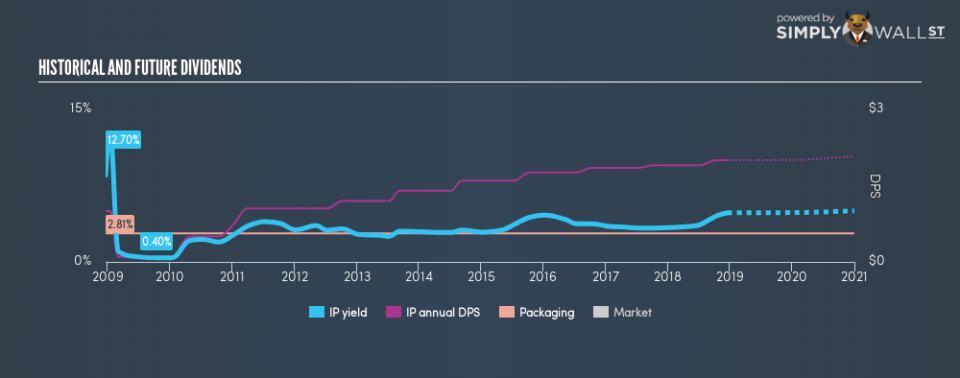Should Investors Buy International Paper Company (NYSE:IP) And Lock In The 4.8% Dividend Yield?

If you are an income investor, then International Paper Company (NYSE:IP) should be on your radar. International Paper Company operates as a paper and packaging company primarily in North America, Europe, Latin America, North Africa, India, and Russia. Over the past 10 years, the US$18b market cap company has been growing its dividend payments, from $1 to $2. Currently yielding 4.8%, let’s take a closer look at International Paper’s dividend profile.
Check out our latest analysis for International Paper
What Is A Dividend Rock Star?
It is a stock that pays a reliable and steady dividend over the past decade, at a rate that is competitive relative to the other dividend-paying companies on the market. More specifically:
Its annual yield is among the top 25% of dividend payers
It consistently pays out dividend without missing a payment or significantly cutting payout
Its dividend per share amount has increased over the past
It can afford to pay the current rate of dividends from its earnings
It has the ability to keep paying its dividends going forward
High Yield And Dependable
International Paper’s dividend yield stands at 4.8%, which is high for Packaging stocks. But the real reason International Paper stands out is because it has a proven track record of continuously paying out this level of dividends, from earnings, to shareholders and can be expected to continue paying in the future. This is a highly desirable trait for a stock holding if you’re investor who wants a robust cash inflow from your portfolio over a long period of time.
If there’s one type of stock you want to be reliable, it’s dividend stocks and their stable income-generating ability. In the case of IP it has increased its DPS from $1 to $2 in the past 10 years. During this period it has not missed a payment, as one would expect for a company increasing its dividend. This is an impressive feat, which makes IP a true dividend rockstar.
International Paper has a trailing twelve-month payout ratio of 28%, meaning the dividend is sufficiently covered by earnings. In the near future, analysts are predicting a higher payout ratio of 37% which, assuming the share price stays the same, leads to a dividend yield of around 4.8%. However, EPS is forecasted to fall to $5.61 in the upcoming year. Therefore, although payout is expected to increase, the fall in earnings may not equate to higher dividend income.
When assessing the forecast sustainability of a dividend it is also worth considering the cash flow of the business. A business with strong cash flow can sustain a higher divided payout ratio than a company with weak cash flow.
Next Steps:
Investors of International Paper can continue to expect strong dividends from the stock. With its favorable dividend characteristics, if high income generation is still the goal for your portfolio, then International Paper is one worth keeping around. However, given this is purely a dividend analysis, I recommend taking sufficient time to understand its core business and determine whether the company and its investment properties suit your overall goals. There are three essential factors you should further examine:
Future Outlook: What are well-informed industry analysts predicting for IP’s future growth? Take a look at our free research report of analyst consensus for IP’s outlook.
Valuation: What is IP worth today? Even if the stock is a cash cow, it’s not worth an infinite price. The intrinsic value infographic in our free research report helps visualize whether IP is currently mispriced by the market.
Other Dividend Rockstars: Are there strong dividend payers with better fundamentals out there? Check out our free list of these great stocks here.
To help readers see past the short term volatility of the financial market, we aim to bring you a long-term focused research analysis purely driven by fundamental data. Note that our analysis does not factor in the latest price-sensitive company announcements.
The author is an independent contributor and at the time of publication had no position in the stocks mentioned. For errors that warrant correction please contact the editor at editorial-team@simplywallst.com.

